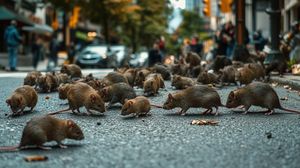On January 29, 2025, the Maha Kumbh Mela, one of the world's largest religious gatherings held in Prayagraj, became the site of tragedy as at least 30 devotees lost their lives and around 60 others sustained injuries during a stampede. The incident unfolded during Mauni Amavasya, considered one of the most auspicious days of the event when millions of pilgrims flocked to the holy site for ritual bathing at the Sangam, the confluence of the rivers Ganges, Yamuna, and the mythical Sarasvati.
Initial reports indicate the stampede was triggered by massive crowds pressing against barricades as devotees hurried to take their holy dip. Eyewitnesses recounted scenes of chaos as the crowd surged, leading to collapsing structures and trampling. The Deputy Inspector General of Kumbh, Vaibhav Krishna, confirmed the number of fatalities and stated, "Footage of the incident will be thoroughly examined, including recordings from cameras installed at the site." This swift inquiry highlights authorities' commitment to understand the circumstances surrounding the incident.
Following the stampede, the Uttar Pradesh government announced immediate measures to bolster safety and management protocols at the Kumbh Mela. A complete no-vehicle zone was established around the fairgrounds, and all VVIP passes were canceled to eliminate exceptions. A one-way traffic system was introduced to streamline movement, with strict vehicle entry bans on four-wheelers remaining until February 4. Chief Minister Yogi Adityanath assured the public of enhanced crowd management strategies and directed officials experienced from managing previous Kumbh events to aid the efforts.
While authorities hurried to implement these changes, the emotional impact of the stampede lingered among families. Survivors who had lost loved ones expressed their grief and despair. Vishal Gautam, who had been trying to locate his father, shared, “I warned them about going on the day of Mauni Amavasya, as I knew there would be larger crowds. But they didn’t listen.”
Tragedy struck not just with the loss of life but also with the disarray of the gathering itself following the stampede. Eyewitness accounts from the locality described scenes of despair, with victims’ families scrabbling to locate each other amid the chaos. Raj Kumar Rauniyar, who was searching for his missing mother after the stampede, painted a vivid picture of the pandemonium. “For over an hour, people were just screaming. Chants of ‘Har Har Gange’ turned to cries for help,” he recounted.
Authorities have now ordered the formation of a three-member judicial commission to investigate the causes of the stampede, with Justice Harsh Kumar leading the inquiry alongside experienced former officials. This commission aims to assess the management of the Kumbh Mela and any lapses leading to the tragic event.
Compensation efforts for victims were also announced, with the government pledging Rs 25 lakh to each family of the deceased. Yet, as survivors and relatives sought answers, many felt the response from local authorities was slow and inadequate. Critics began to voice concerns about crowd management and the apparent disparity between the treatment of ordinary devotees and VIP attendees.
Reports surfaced of continued conflicts among attendees and police, with many complainants noting how some privileged individuals received preferential treatment, being allowed to navigate through restricted zones. “When there are so many people, such an incident is bound to happen,” reflected one devotee, indicating broader frustrations with the handling of the mega event.
Further complicity and confusion arose from reports of alleged second stampede-like incidents occurring shortly after the primary event. Police initially denied these claims but later indicated they would investigate the situation for clarity.
Despite the harrowing circumstances post-stampede, the local community displayed remarkable solidarity. Schools and nearby religious institutions opened their doors, offering shelter, food, and water for the stricken devotees. Mohammed Anas, a local businessman, noted how shops were transformed overnight to accommodate desperate travelers seeking refuge.
Meanwhile, officials continued to adapt strategies to avoid future disasters. Stricter entry protocols were enforced, allowing only small groups to enter the fairgrounds as additional medical posts were established for those needing immediate assistance. Planning for the upcoming auspicious days of Amrit Snan remains rigorous, as authorities push for ‘zero error’ management to regain public confidence.
Residents and pilgrims, still processing the events of January 29, voiced their concerns about the safety and organization of such large-scale gatherings. Many shared their frustrations about poor access and unsafe conditions. Anuradha Srivastava, a pilgrim, stated, “People have to walk more than 10 km to reach the ghats, which seems unreasonable.” The echoes of distrust resonate as public and civilian narratives beg for assurance.
Reflecting on the intertwined fates of faith and tragedy at this year’s Kumbh, both the survivors and the local administration face the formidable task of healing. Until the causes of these tragedies are addressed and safety becomes prioritized, the sacredness of this pilgrimage may continue to be overshadowed by fear amid the holy waters.



